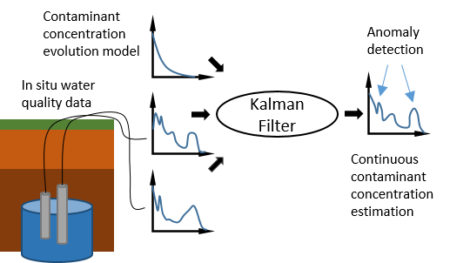A real-time, in-situ, ‘smart’ monitoring and early warning system for migrating and reacting contaminant plumes was developed using a Kalman filter-based framework and successfully tested at the contaminated Savannah River Site.

Figure 2. System validation using historical, cheap proxy variables (specific conductance and pH) to estimate U-238
As this framework enables easy integration of networked, autonomous and inexpensive wellbore measurements with cloud computing, the approach is expected to reduce groundwater monitoring cost, increase confidence in the efficacy of monitored natural attenuation, and ensure early response if needed.
Summary
- A Kalman filter method was used to estimate contaminant concentrations continuously and in real-time by coupling data-driven concentration decay models with data correlations.
- The approach was successfully demonstrated using historical groundwater data from the Uranium and Tritium-contaminated Savannah River Site F-Area
- Specific conductance and pH were used as proxy variables to estimate tritium and uranium concentrations over time.
- Results show that the developed method can estimate contaminant concentrations based on in-situ, easily measured variables
Citation
Schmidt, F., Wainwright, H. M., Faybishenko, B., Denham, M., & Eddy-Dilek, C. (2018). In Situ Monitoring of Groundwater Contamination Using the Kalman Filter. Environmental Science & Technology, DOI: 10.1021/acs.est.8b00017.

